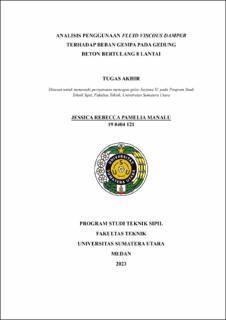| dc.description.abstract | Earthquake-resistant building structure planning is very important in Indonesia given that the Indonesian archipelago is located in earthquake-prone areas. Along with the development of earthquake-resistant building planning technology, many varied structural system designs have emerged. Currently, a new method has been developed to overcome the large earthquake vibration energy in building structures, namely by using dampers. In this final project, seismic devices, namely fluid viscous dampers, are discussed. This research aims to compare structures that use fluid viscous dampers and those that do not use fluid viscous dampers. In this final project, the modeled structure is an 8-story building located in the city of Tebing Tinggi. The building structure is modeled with the help of the Midas Gen 2022 program. The earthquake load is planned using the time history analysis method, namely the El Centro, Parkfield, Northridge, San Fernando, and Oakland earthquakes. Based on the results of the analysis, it can be concluded that structures that use fluid viscous dampers are able to reduce displacement, structural period, moment and shear force that occurs. In structures that use fluid viscous dampers, the drift value obtained decreases from buildings that do not use fluid viscous dampers, this is due to the shrinking displacement value so that the drfit ratio also decreases | en_US |


